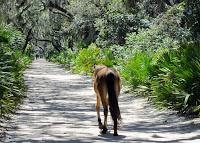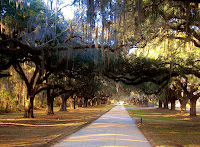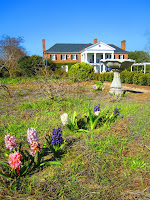To pitch my tent with no prosy plan, To range and to change at will; To mock at the mastership of man, To seek Adventure's thrill.
April 19, 2013
April 17, 2013
Boone Hall Plantation
Next on my itinerary was a destination that is not a National Park Site (shocking!). However, as soon as I saw pictures of the famous avenue of oaks, I knew that I had to stop by (even though it cost me $18).
It is an antebellum
plantation located in Mount Pleasant, South Carolina and listed on the National
Register of Historic Places.
The historic "Avenue of Oaks" greeted me upon arrival. It is a nearly
one-mile drive up to the large Colonial Revival plantation
house with live oaks on either side,
originally planted in 1743.
There are several events going on throughout the day at Boone Hall and I was determined to catch them all. First up was strolling through the gardens that are on the front lawn. The are beautifully landscaped but I was a few weeks too early for a lot of blooms to be out. It was still beautiful though.
 Alongside the avenue of oaks is the Slave Street that contains nine original slave cabins. These cabins were occupied by sharecroppers well into the 20th century. Each cabin presents a
historical look at the living quarters, historic relics, and lifestyle of the
slaves that lived here at Boone Hall. It was an amazing history lesson on the area.
Alongside the avenue of oaks is the Slave Street that contains nine original slave cabins. These cabins were occupied by sharecroppers well into the 20th century. Each cabin presents a
historical look at the living quarters, historic relics, and lifestyle of the
slaves that lived here at Boone Hall. It was an amazing history lesson on the area.
Next up I hopped on a plantation coach tour which takes you on a 40 minute motorized tour around the plantation. This ride covers one end
of the plantation to the other...both geographically and historically. I didn't know that Boone Hall is still a working plantation that grows crops like strawberries, tomatoes, corn, watermelon, squash, blueberries,
blackberries, cucumbers, and more. There also used to be a brick factory there, and the slave cabins on the property were built from discarded bricks.I was excited to see cotton up close for the first time!
 |
| Drove past this guy in the coach |
No photos are allowed in the house and the tour is only on the first floor but it was nice to just focus on the furnishings and the history and not be distracted by taking photos. As we exited, the sun was setting over the creek and the guide informed me that when you go swimming in the creek, you are guaranteed to be within 50 feet of a shark!
On the coach tour, our guide told us that Boone Hall has a market down the street where they sell products grown at the farm so I headed over to grab dinner of strawberries and cheese. I loved Boone Hall so much that I ended up going back the next day. What's great is that you can use your same ticket without paying extra and when I showed it to the admission guy at the gate he said "welcome back, glad to see you came to see us again". How great is that!?
The reason I came back is because I had missed the showing of "Exploring The Gullah Culture". Boone Hall Plantation is the only plantation in the S.C.
Lowcountry to present a live presentation of this unique culture adapted by
African slaves. I am so glad I came back to check it out because it was really interesting. However, being that it was a Saturday the plantation was packed and there was even a bride taking wedding photos. I kind of missed when I had the plantation all to myself the day before. Boone Hall is a spectacular place to visit regardless and I am so glad I got to spend so much time there.
April 14, 2013
Tybee Island and Fort Pulaski
Friday morning I decided to swing by Tybee
Island which is 18 miles east of Savannah since Fort Pulaski didn’t open until
9am. My main interest in Tybee Island was that the film “The Last Song” with
Miley Cyrus was filmed there so I decided to do the movie start tour of Tybee
Island. First up was the iconic lighthouse.
I then headed over to the house that was used in the movie but its kind of set back from the road so it was hard to see. I walked along the beach in front to get a better look but it is set back behind some dunes so you can't get too close.
I then perused the boardwalk and finally tried to find the church that plays a pivotal role in the movie. However, the church was originally built in a different location for the movie and then moved in recent years. The funny thing is that the church sits on the main road as you drive into Tybee Island but because its such a different setting from the movie, I drove past it a few times before I realized I had the right church. I felt like a paparazzi trying to get pictures of all these locations.
 I finally headed over to Fort Pulaski which is located off the causeway
between Savannah and Tybee Island. I got there right as a tour was starting and
got to hear from a polished Southern gentleman all about the Fort and its role
in the war.
I finally headed over to Fort Pulaski which is located off the causeway
between Savannah and Tybee Island. I got there right as a tour was starting and
got to hear from a polished Southern gentleman all about the Fort and its role
in the war.
 It is a large brick fort and walls are eleven feet thick, which
were thought to be impenetrable except by only the largest land artillery-
which at the time were smooth bore cannon. These cannons had a range of only
around a half mile, and the nearest land (Tybee island) was much further away
than that. It was assumed that the Fort would be invincible to enemy attack.
It is a large brick fort and walls are eleven feet thick, which
were thought to be impenetrable except by only the largest land artillery-
which at the time were smooth bore cannon. These cannons had a range of only
around a half mile, and the nearest land (Tybee island) was much further away
than that. It was assumed that the Fort would be invincible to enemy attack. 
Tybee Island was thought to be too isolated and unprepared for conflict and was abandoned by Confederate forces which allowed Union troops to gain a foothold where they began construction of batteries along the beaches of Tybee. In 1862 the Union Army successfully tested a rifled cannon and within thirty hours, the new rifled cannon had breached one of the fort's corner walls. Therefore the fort was surrendered and was now pretty much obsolete. So much for being the latest and greatest.
It is a sizeable fort and pretty cool
to explore around. I really liked these passages that took you around underground; I hadn't seen that at a fort before.
April 10, 2013
Georgia on My Mind
 Thursday we awoke to the same chill in the
air but with the wind having finally died down, it was a much better day
already. We rode our bikes back to the dock to return them and picked up a cart
to pack up camp. While we were dismantling the tent, the zipper broke resulting
in the death of Jess’ beloved Chateau. It was somehow fitting though because
Cumberland Island was actually the very first place Chateau was used 10 years
ago on Jess’ first trip to the island. RIP Chateau!
Thursday we awoke to the same chill in the
air but with the wind having finally died down, it was a much better day
already. We rode our bikes back to the dock to return them and picked up a cart
to pack up camp. While we were dismantling the tent, the zipper broke resulting
in the death of Jess’ beloved Chateau. It was somehow fitting though because
Cumberland Island was actually the very first place Chateau was used 10 years
ago on Jess’ first trip to the island. RIP Chateau! |
| River trail |
While waiting for the ferry I hiked down to the Dungeness dock via the River Trail to look for more wild horses but alas I did not see any. After arriving back in St. Mary’s we packed up our respective cars and said our goodbyes as Jess headed back home and I drove north to Savannah. Until our next adventure Jess!
 |
| St. Simon's Light |
While on the way to Savannah I decided to stop at several of the islands in Georgia known as the Golden Isles. First up was St. Simons Island where my destination was Fort Frederica which preserves the archaeological remnants of a fort and town built by James Oglethorpe between 1736 and 1748 to protect the southern boundary of the British colony of Georgia from Spanish raids. About 630 British troops were stationed at the fort.
 A town
of up to 500 colonial residents then grew up outside the fort. Although there’s
only a few ruins left at the site it is still really interesting to experience
because there have been archaeological investigations where they have excavated
sections of the fort and village and several wayside exhibits show what they
have found and extrapolate what building was on the site.
A town
of up to 500 colonial residents then grew up outside the fort. Although there’s
only a few ruins left at the site it is still really interesting to experience
because there have been archaeological investigations where they have excavated
sections of the fort and village and several wayside exhibits show what they
have found and extrapolate what building was on the site.
Just down the road from Fort Frederica is Christ Church which is gorgeous!
The next island was Jekyll Island which costs $6 to enter but is worth it. One of the highlights is the Horton House which is a two-story structure built from tabby in 1742 that now stands in ruins. This structure has been meticulously preserved over the past 100 years as an example of coastal Georgia building techniques and as one of the oldest surviving buildings in the state.
 |
| Horton House |
The island is most famous for the Jekyll Island Club Historic District. The centerpiece of the grounds is the enormous Jekyll Island Club Hotel where there was a picturesque scene of old people dressed all in white playing a game of croquet on the front lawn. The whole place seemed like a movie set because it was just so picture perfect.

 I then made it down
to the famous Riverfront. There are signs along the way telling the story of
the river and the history of Savannah.
I then made it down
to the famous Riverfront. There are signs along the way telling the story of
the river and the history of Savannah.
It was a beautiful night in Savannah and
it was so relaxing to stroll along the river as the sun was setting. I grabbed a delicious dinner and capped it off by getting free samples of pralines for a true Georgia experience.
April 7, 2013
Cumberland Island
 The plan for the next
2 days was to catch the ferry to Cumberland Island in Georgia and camp
overnight but we both seriously considered taking the ferry back the same day
because a cold front moved through and we awoke to a cold and windy day with
wind chills in the 30s! However, we aren’t ones to shy away from a bit of nasty
weather so we bundled up (thank goodness Jess had provided me with a winter
coat!) and trudged onto the ferry. The ferry is a walk on, passenger only
ferry. The ride over to Cumberland is about 40 minutes and upon arrival we had
to unload all of our gear and go to a short orientation about camping.
Basically keep all your food locked up and don’t ride the wild horses.
The plan for the next
2 days was to catch the ferry to Cumberland Island in Georgia and camp
overnight but we both seriously considered taking the ferry back the same day
because a cold front moved through and we awoke to a cold and windy day with
wind chills in the 30s! However, we aren’t ones to shy away from a bit of nasty
weather so we bundled up (thank goodness Jess had provided me with a winter
coat!) and trudged onto the ferry. The ferry is a walk on, passenger only
ferry. The ride over to Cumberland is about 40 minutes and upon arrival we had
to unload all of our gear and go to a short orientation about camping.
Basically keep all your food locked up and don’t ride the wild horses.

 To get
to the campground you then have to haul your gear about a half mile into the
island. The campground is very small and quite dense with foliage so you can’t
see any other campers and the sites are huge so I was quite impressed. Thank
goodness for all the trees because they helped block the wind.
To get
to the campground you then have to haul your gear about a half mile into the
island. The campground is very small and quite dense with foliage so you can’t
see any other campers and the sites are huge so I was quite impressed. Thank
goodness for all the trees because they helped block the wind.
The best way to see the island is on bikes so we rented some and headed down to Dungeness Ruins. On the ride there we got to see our first wild horse!
Dungeness is a ruined mansion that is part of a historic district that was the home of several families significant in American history including: James Oglethorpe, Nathanael Greene, Henry Lee III and Thomas M. Carnegie. In 1959 the Dungeness mansion was destroyed by fire and its hard to fathom what it looked like in its original grandeur because the ruins are so huge.
Other Carnegie estates were built for his children, including Plum Orchard which is a 20,000 square foot, Georgian Revival mansion. It is almost 8 miles from the Sea Camp dock to visit Plum Orchard and it’s a hell of a bike ride. The road is sandy and for the most part it is packed but there are some parts where you get bogged down. Jess was not feeling the bike ride and towards the end I was ready to forget about reaching the mansion too but we trudged on.
What was infuriating was that NPS vehicles kept driving by us on the road. Why can’t you shuttle people to Plum Orchard National Park Service!!?
 |
| Smiling through the pain |
One bright spot was seeing the armadillos that were everywhere along the road. For some reason I find them really adorable! Maybe it's because Jess says Vin Diesel looks like an armadillo :)

We finally arrived and the mansion wasn’t even open so we just walked around the exterior, checked out some wild horses and rested on the grand porch.
Finally we forced ourselves to get back on the bikes and slog all the way back to camp where we wearily cooked dinner. Fortunately Jess had brought tea so we heated up some water and were able to warm ourselves with a cup of tea that we enjoyed on the beach as the sun was setting.
 |
| Brrrr |
Subscribe to:
Comments (Atom)
































